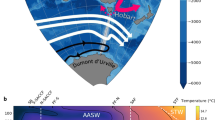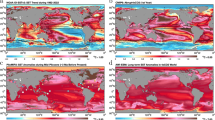Abstract
Evidence for abrupt climate changes on millennial and shorter timescales is widespread in marine and terrestrial climate records1,2,3,4. Rapid reorganization of ocean circulation is considered to exert some control over these changes5, as are shifts in the concentrations of atmospheric greenhouse gases6. The response of the climate system to these two influences is fundamentally different: slowing of thermohaline overturn in the North Atlantic Ocean is expected to decrease northward heat transport by the ocean and to induce warming of the tropical Atlantic7,8, whereas atmospheric greenhouse forcing should cause roughly synchronous global temperature changes9. So these two mechanisms of climate change should be distinguishable by the timing of surface-water temperature variations relative to changes in deep-water circulation. Here we present a high-temporal-resolution record of sea surface temperatures from the western tropical North Atlantic Ocean which spans the past 29,000 years, derived from measurements of temperature-sensitive alkenone unsaturation in sedimentary organic matter. We find significant warming is documented for Heinrich event H1 (16,900–15,400 calendar years bp) and the Younger Dryas event (12,900–11,600 cal. yr bp), which were periods of intense cooling in the northern North Atlantic. Temperature changes in the tropical and high-latitude North Atlantic are out of phase, suggesting that the thermohaline circulation was the important trigger for these rapid climate changes.
This is a preview of subscription content, access via your institution
Access options
Subscribe to this journal
Receive 51 print issues and online access
$199.00 per year
only $3.90 per issue
Buy this article
- Purchase on Springer Link
- Instant access to full article PDF
Prices may be subject to local taxes which are calculated during checkout

Similar content being viewed by others
References
Dansgaard,W. et al. Evidence for general instability of past climate from a 250-kyr ice-core record. Nature 364, 218– 220 (1993).
Bond,G. et al. Correlations between climate records from North Atlantic sediments and Greenland ice. Nature 365, 143– 147 (1993).
Charles,C. D., Lynch-Stieglitz,J., Ninnemann,U. S. & Fairbanks,R. G. Climate connections between the hemisphere revealed by deep sea sediment core/ice core correlations. Earth Planet. Sci. Lett. 142, 19–27 (1996).
Bard,E., Rostek,F. & Sonzogni,C. Interhemispheric synchrony of the last deglaciation inferred from alkenone palaeothermometry. Nature 385 , 707–710 (1997).
Broecker,W. S., Peteet,D. M. & Rind,D. Does the ocean–atmosphere system have more than one stable mode of operation. Nature 315, 21–26 (1985).
Broecker,W. S. Massive iceberg discharges as triggers for global climate change. Nature 372, 421–424 ( 1994).
Crowley,T. J. North Atlantic Deep Water cools the southern hemisphere. Paleoceanography 7, 489–497 ( 1992).
Manabe,S. & Stouffer,R. J. Coupled ocean-atmosphere model response to freshwater input: Comparison to Younger Dryas event. Paleoceanography 12, 321–336 (1997).
Manabe,S., Stouffer,R. J., Spelman,M. J. & Bryan,K. Transient response of a coupled ocean-atmosphere model to gradual changes of atmospheric CO2. Part I: Annual mean response. J. Clim. 4, 785–818 ( 1991).
Blunier,T. et al. Asynchrony of Antarctic and Greenland climate change during the last glacial period. Nature 394, 739– 743 (1998).
Vidal,L. et al. Link between the North and South Atlantic during the Heinrich events of the last glacial period. Clim. Dyn. (in the press).
Thompson,L. G. et al. A 25,000-year tropical climate history from Bolivian ice cores. Science 282, 1858– 1864 (1998).
Lowell,T. V. et al. Interhemispheric correlation of Late Pleistocene glacial events. Science 269, 1541– 1549 (1995).
Prahl,F. G. & Wakeham,S. G. Calibration of unsaturation patterns in long-chain ketone compositions for paleotemperature assessment. Nature 330, 367–369 ( 1987).
Müller,P. J., Kirst,G., Ruhland,G., von Storch,I. & Rosell-Melé,A. Calibration of the alkenone paleotemperature index UK′ 37 based on core-tops from the eastern South Atlantic and the global ocean (60°N-60°S). Geochim. Cosmochim. Acta 62, 1757– 1772 (1998).
Sonzogni,C. et al. Temperature and salinity effects on alkenone ratios measured in surface sediments from the Indian Ocean. Quat. Res. 47, 344–355 (1997).
Pelejero,C. & Grimalt,J. O. The correlation between UK′ 37 index and sea surface temperatures in the warm boundary: The South China Sea. Geochim. Cosmochim. Acta 61, 4789–4797 (1997).
Prahl,F. G., de Lange,G. J., Lyle,M. & Sparrow,M. A. Post-depositional stability of long-chain alkenones under contrasting redox conditions. Nature 341, 434–437 ( 1989).
Broecker,W. Glacial climate in the tropics. Science 272, 1902–1904 (1996).
CLIMAP Project Members Seasonal Reconstruction of the Earth's Surface at the Last Glacial Maximum (Map & Chart Ser. MC-3, Geol. Soc. Am., Boulder, Colorado, 1981).
Guilderson,T. P., Fairbanks,R. G. & Rubenstone,J. L. Tropical temperature variations since 20,000 years ago: Modulating interhemispheric climate change. Science 263, 663–665 (1994).
Mix,A. C., Morey,A. E., Pisias,N. G. & Hostetler,S. W. Foraminiferal fauna estimates of paleotemperature: Circumventing the no-analog problem yields cool ice age tropics. Paleoceanography 14, 350–359 (1999).
Hastings,D. W., Russell,A. D. & Emerson,S. R. Foraminiferal magnesium in Globigerinoides sacculifer as a paleotemperature proxy. Paleoceanography 13, 161–169 (1998).
Schrag,D. P., Hampt,G. & Murray,D. W. Pore fluid constraints on the temperature and oxygen isotopic composition of the glacial ocean. Science 272, 1930–1932 (1996).
Fairbanks,R. G. A 17,000-year glacio-eustatic sea level record: influence of glacial melting rates on the Younger Dryas event and deep-ocean circulation. Nature 342, 637–642 ( 1989).
Betts,A. K. & Ridgway,W. Tropical boundary layer equilibrium in the last ice age. J. Geophys. Res. 97, 2529–2534 (1992).
Crowley,T. J. & Baum,S. K. Effect of vegetation on an ice-age climate model simulation. J. Geophys. Res. 102, 16463–16480 (1997).
Hüls,M. & Zahn,R. Millennial-scale SST variability in the western subtropical North Atlantic from planktonic foraminiferal census counts. Paleoceanography (submitted).
Boyle,E. A. & Keigwin,L. North Atlantic thermohaline circulation during the past 20,000 years linked to high-latitude surface temperature. Nature 330, 35–40 (1987).
Arz,H. W., Pätzold,J. & Wefer,G. The deglacial history of the western tropical Atlantic as inferred from high resolution stable isotope records off northeastern Brazil. Earth Planet. Sci. Lett. 167, 105– 117 (1999).
Zhao,M., Beveridge,N. A. S., Shackleton,N. J., Sarnthein,M. & Eglinton,G. Molecular stratigraphy of cores off northwest Africa: Sea surface temperature history over the last 80 ka. Paleoceanography 10, 661– 675 (1995).
Villanueva,J. & Grimalt,J. O. Gas chromatographic tuning of the UK′ 37 paleothermometer. Anal. Chem. 69, 3329–3332 (1997).
Hughen,K. A. et al. Deglacial changes in ocean circulation from an extended radiocarbon calibration. Nature 391, 65– 68 (1998).
Stuiver,M. & Reimer, P. J. Extended 14C data base and revised CALIB 3. 0 14C age calibration program. Radiocarbon 35, 215–230 (1993).
Johnsen,S. J., Dansgaard,W., Clausen,H. B. & Langway,C. C. Oxygen isotope profiles through the Antarctic and Greenland ice sheets. Nature 235, 429–434 ( 1972).
Acknowledgements
We thank A. Rosell-Melé, R. Schneider and A. Paul for comments on the manuscript, M. Hüls for discussions, and P. Grootes and staff of the Leibnitz-Labor in Kiel for providing AMS 14C datings. This work was supported by the Deutsche Forschungsgemeinschaft.
Author information
Authors and Affiliations
Corresponding author
Rights and permissions
About this article
Cite this article
Rühlemann, C., Mulitza, S., Müller, P. et al. Warming of the tropical Atlantic Ocean and slowdown of thermohaline circulation during the last deglaciation. Nature 402, 511–514 (1999). https://doi.org/10.1038/990069
Received:
Accepted:
Issue Date:
DOI: https://doi.org/10.1038/990069
This article is cited by
-
Deglacial increase of seasonal temperature variability in the tropical ocean
Nature (2022)
-
Initiation of a stable convective hydroclimatic regime in Central America circa 9000 years BP
Nature Communications (2020)
-
A global database of Holocene paleotemperature records
Scientific Data (2020)
-
More efficient North Atlantic carbon pump during the Last Glacial Maximum
Nature Communications (2019)
-
Synchronous precipitation reduction in the American Tropics associated with Heinrich 2
Scientific Reports (2017)
Comments
By submitting a comment you agree to abide by our Terms and Community Guidelines. If you find something abusive or that does not comply with our terms or guidelines please flag it as inappropriate.



